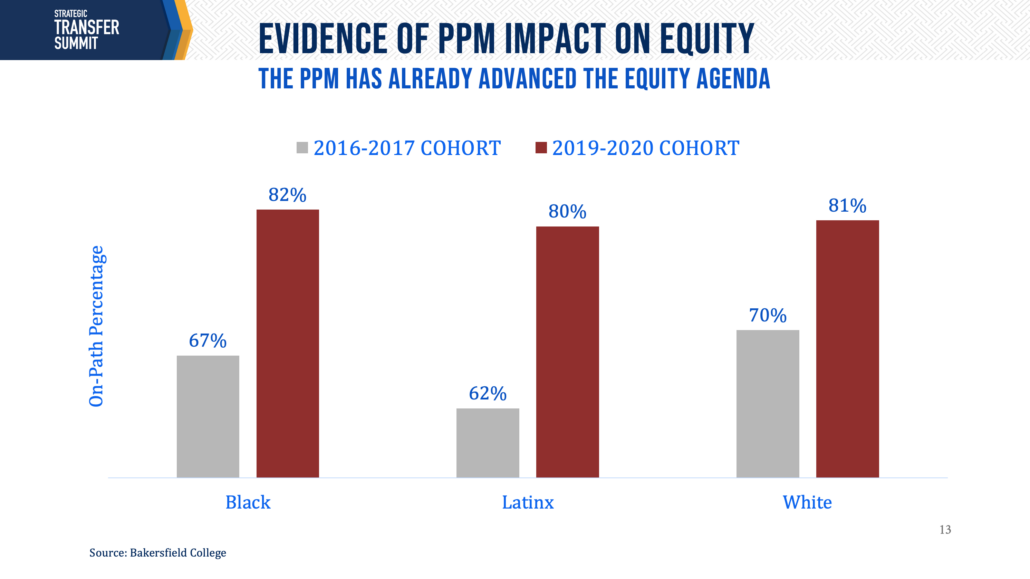Persistence: commitment with intelligence
With 2025 well into its second month, the Central Valley Higher Education Consortium presents here a look at the success of our Central Valley Transfer Project that was catapulted into the state limelight when it was declared a California Community Colleges Demonstration Project by Chancellor Dr. Sonya Christian in fall 2023. CVHEC’s Central Valley Transfer Project Lead Stan Carrizosa, president-emeritus of COS, reports that 12 of the 15 Central Valley Higher Education Consortium-member community colleges are now on board along with members UC Merced and our three CSU campuses: Bakersfield, Fresno and Stanislaus. Carrizosa updates how “the Central Valley Way” of collaboration and “working smarter, not harder” that characterizes CVHEC initiatives is spreading into a statewide effort to increase successful community college transfers with the implementation of the project’s software platform, Program Pathways Mapper (PPM). He notes that funding to implement the PPM software — which is increasing the rate of successful community college transfers who utilize it to efficiently navigate their journey to a degree or certificate — is available to any community college for their students.
BY STAN CARRIZOSA
CVHEC Central Valley Transfer Project Lead
In 2018, a group of community college leaders, meeting in the annual gathering of the Central Valley Higher Education Consortium Board of Directors, heard Dr. James Zimmerman, University of California, Merced senior administrator, share an update on the number of Central Valley community college students that had successfully transferred to UC Merced.
The results were dismal, Dr. Zimmerman reported, and UC Merced asked to meet with community college officials to enact a plan to increase successful transfers to UC Merced. The Central Valley Transfer Project was born.
A pilot for the project was funded through a state grant that engaged Merced College and Bakersfield College representatives in convenings with UC Merced staff to create successful transfer pathways from community college. In the beginning, the process was slow and arduous as many details and factors needed to be discussed and incorporated into creating those pathways.
UC Merced graciously broadened the scope of the project to review the already successful Associate Degree for Transfer (ADT) pathways for transfer to CSUs. One-by-one different majors were reviewed, and UC Merced began accepting the ADTs as fulfilling the lower division requirements for successful transfer.
The pilot project ended with both Merced and Bakersfield College having approved multiple ADTs that would fulfill requirements for successful transfer to UC Merced.
The tool for combing combining? these lower division courses with their upper division requirements at UCM is a software platform called Program Pathways Mapper (PPM). PPM is a public-facing, internet-based URL that is easily accessible for students, parents, teachers, counselors and advisors. It is an application that is uploaded on our smart phone that enables us to see the lower division courses required for an ADT and the upper division coursework at the four-year college to complete a degree in the corresponding discipline major.
Taking it statewide – PPM funding available for colleges
PPM has since expanded and is now used statewide by community colleges, CSUs and UCs. It became such an advantage for students that a request was made for the state budget to fund the one-time costs for joining PPM and was approved by the Governor Newsome and California Legislature in 2022. Any community college can receive funding if requested to implement PPM for their students.
This combination of highly efficient convening protocols combined with easily accessible mapping software has spread across the state. In the Central Valley, all but three of the 15 community colleges are now on board along with UC Merced, CSU Bakersfield, Fresno State and CSU Stanislaus.
State Community College Chancellor Dr. Sonya Christian declared the Central Valley Transfer Project a statewide Demonstration Project in her newly adopted “Vision 2030.” The CSU and UC system’s CEOs have also endorsed the Transfer Project and statewide effort to increase successful community college transfers.
Each step along the way, the Central Valley Transfer Team has tried to work smart by leveraging existing structures including ADTs and even dual enrollment for some community college’s by aligning and connecting these structures increasing their effectiveness for successful transfers. This type of intersegmental collaboration requires patience and, more than anything, persistence.
The natural resistance to change is ever-present. A feeling of “initiative overload” and fatigue exist, and the inertia inherent in any bureaucracy requires persistence which we have come to define as commitment with intelligence, often referred to as “working smarter, not harder.”
What the data shows
Baseline data on results are very encouraging. A control group of 5,000 incoming freshman to Bakersfield College were tracked comparing PPM users and non-PPM users over their first two semesters. Leaving all other recruitment services and outreach efforts in place the only variable that differed for these groups were those who used PPM to work their education plan and those who did not.
A review of the percentage of on-path course completion was measured among both groups to see if PPM provided any advantage in increasing students’ completion of required courses on-path to their degree. Both groups were reviewed for the number of units to degree in hopes that PPM would help reduce the number of unnecessary units completed.
Perhaps most importantly, tracking the differences in percentage of on-path course completion rates between subgroups of students by ethnicity addresses equity in success among different groups.
See our results in the graphics above.
Once Chancellor Christian designated this a Demonstration Project in her Vision 2030, the Central Valley way has begun to influence positive results for students statewide and beyond. The success of the project now reaches as far north as UC Santa Cruz all the way south to UCLA and UC Irvine. Community college transfer to the CSU system make up 50 percent of all their successful graduates.
Increasing successful transfers is a very effective strategy in the quest to increase four-year degree attainment!
CVHEC media inquiries: Tom Uribes – cvheccommunications@mail.fresnostate.edu or text 559.348.3278.
- CVHEC Web Site Feature: Transfer Project
- Central Valley Transfer Project: valley’s four-year colleges collaborating – Feb. 23, 2024
- WHAT THE CV-HEC IS HAPPENING BLOG (January 2024): CVHEC 2023 — surging forward for Central Valley students (By Stan A. Carrizosa, Sr., CVHEC) – Jan. 18, 2024
- HIGHER ED NEWS: College Bridge to expand Math Bridge; CVHEC Transfer Project – Jan. 18, 2024
- CVHEC Summit: CCC Chancellor announces Transfer Pathways Demonstration – Nov. 6, 2023
- Historic Transfer Project spurs statewide movement to increase transfer rates – Oct. 10, 2023
- Historic CVHEC Transfer Project/Program Mapper Featured at CSSO – March 19, 2023
- ‘First of its Kind’ CVHEC Transfer Project Gaining Statewide Interest – Jan.24, 2023
- CCLC Convention Re-emergence Features CVHEC Transfer Project/Mapper Panel – Sept. 21, 2022)
- CV-HEC BLOG: UC Enrollment Push Supported by CVHEC/UC Merced Transfer Project and New Mapper Software (By James Zimmerman, UC Merced) – June 23, 2022
- Pilot CVHEC/UC Merced Transfer Project improves process for students – Sept. 23, 2021
- Central Valley Transfer Project Archives
- A-G
- Career Technical Education




